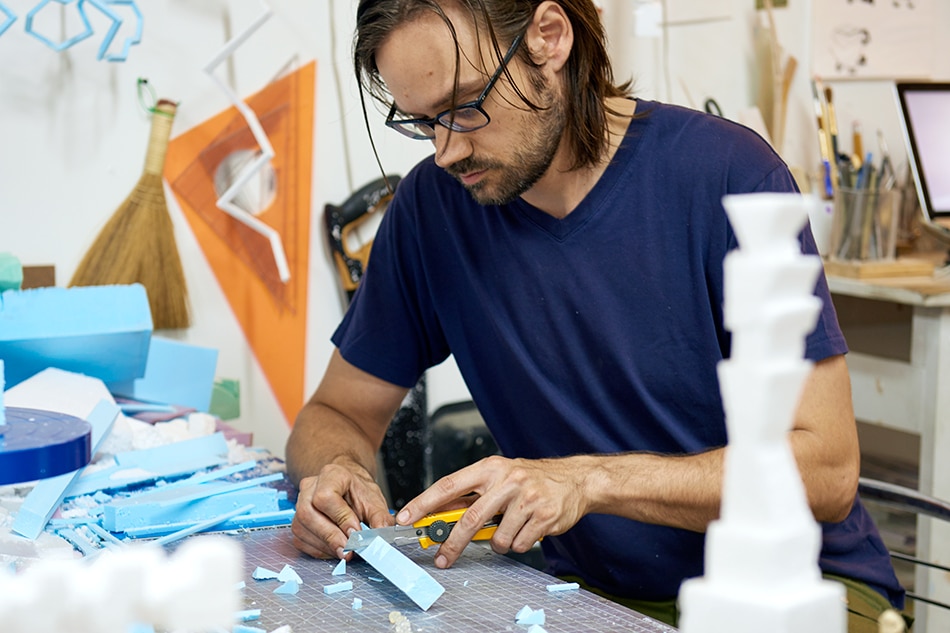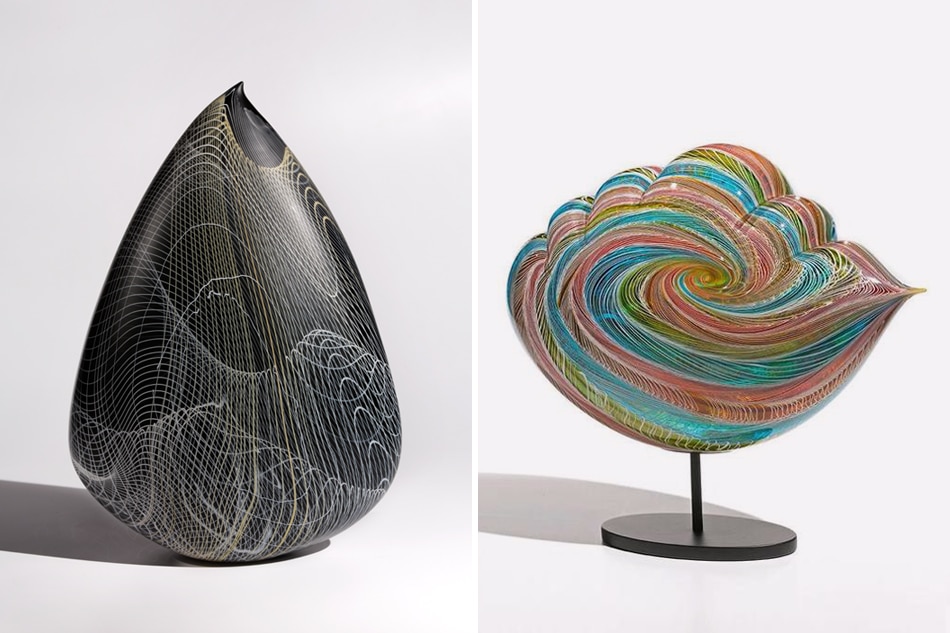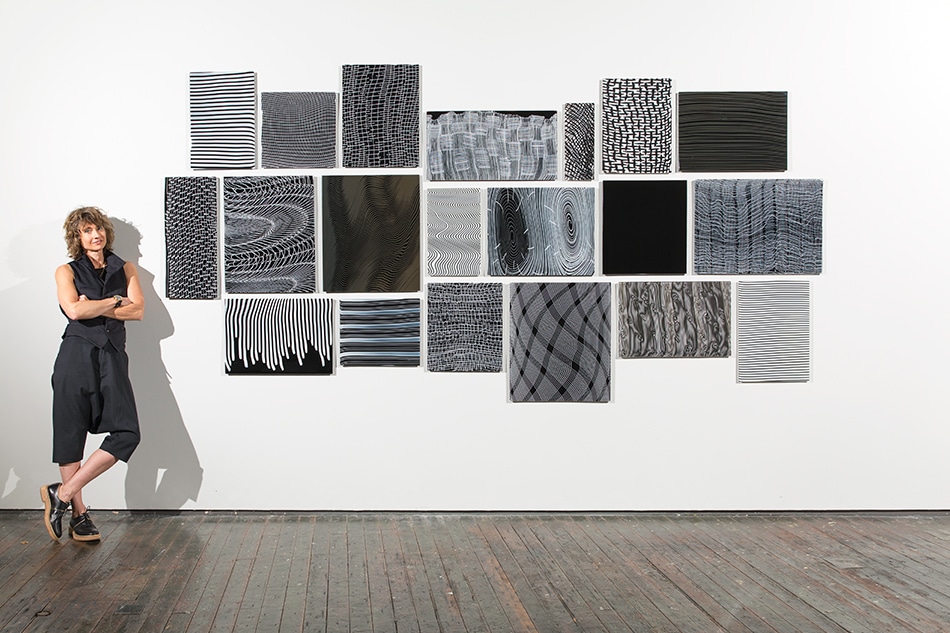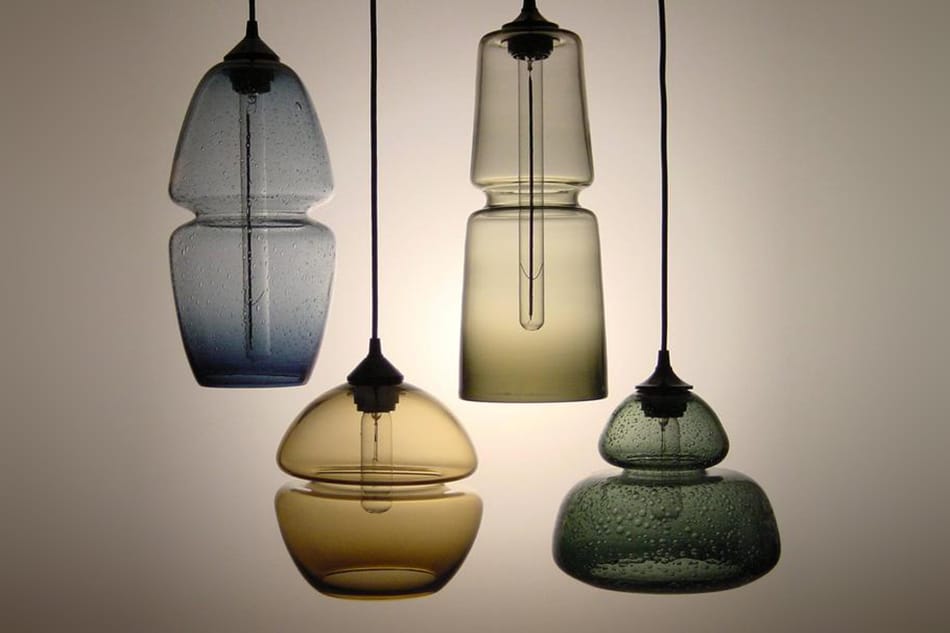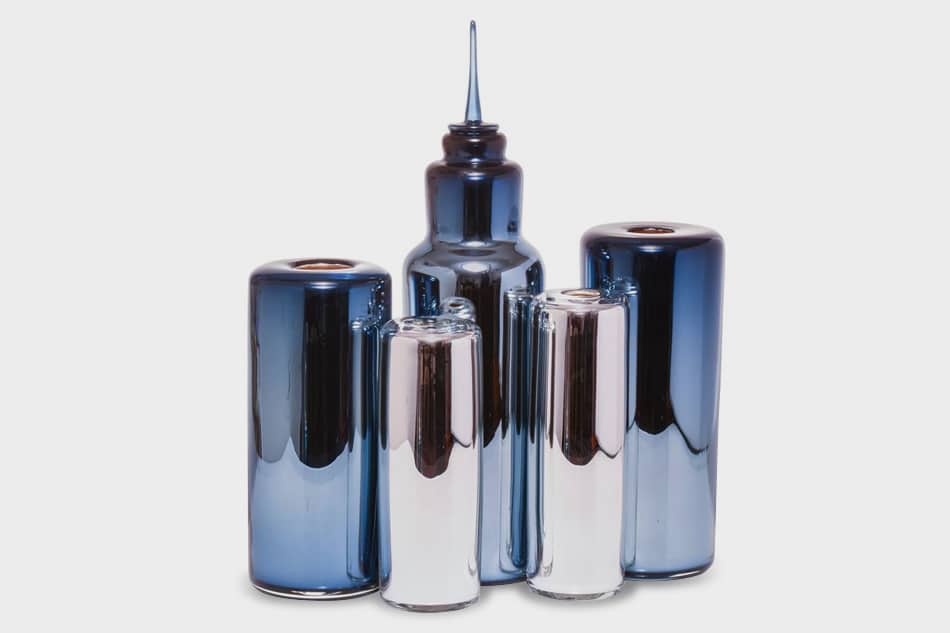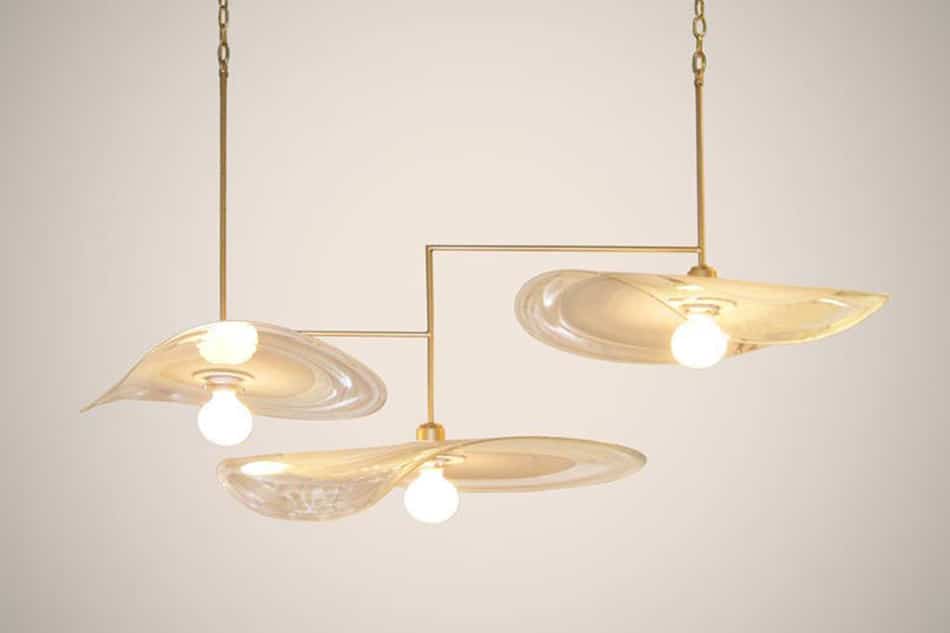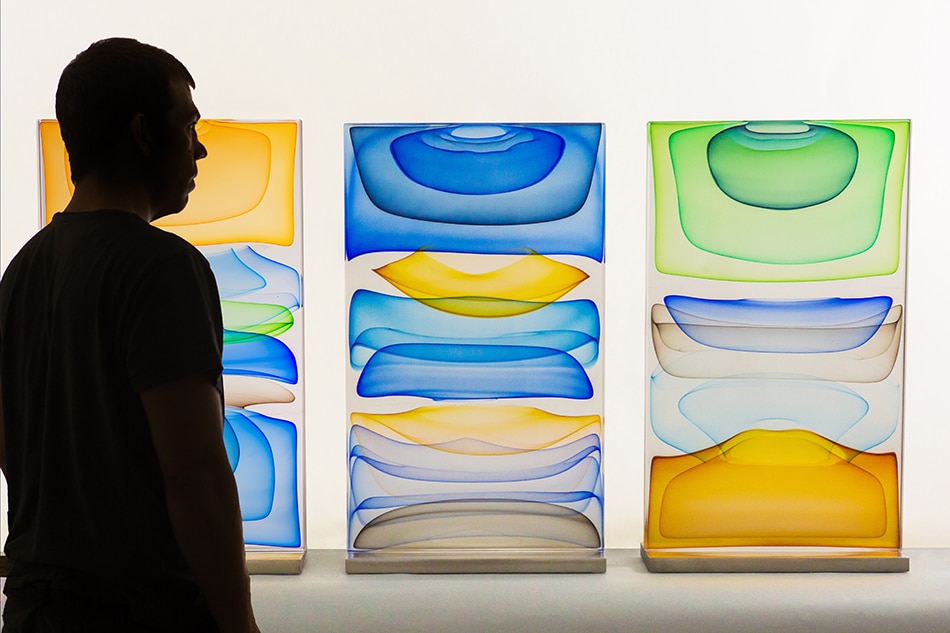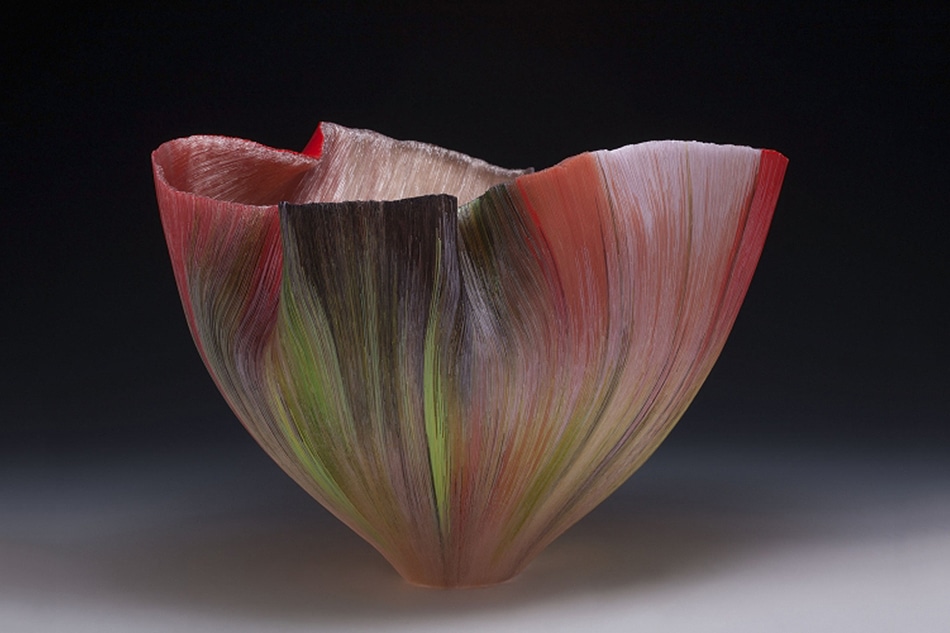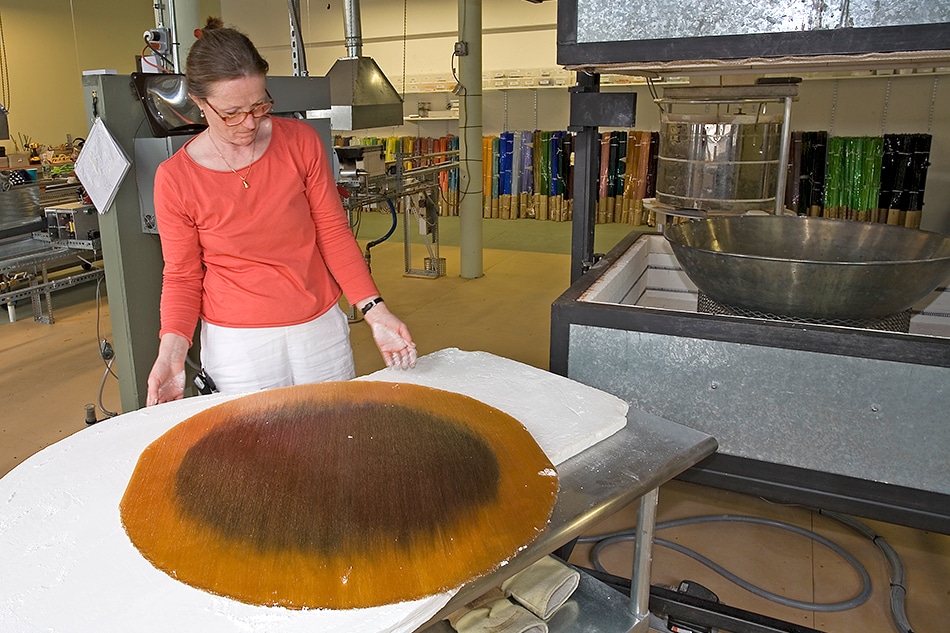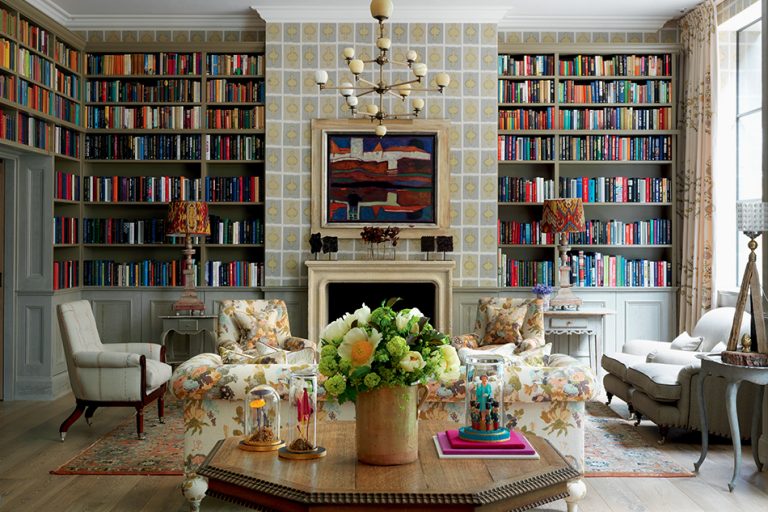
August 21, 2017The headquarters of the Fort Greene, Brooklyn, art-glass studio UrbanGlass underwent a $62 million top-to-bottom renovation and expansion from 2011 to 2013. Photo by Mark Hall. Top: a detail of South Seas Cloud, 2015, by Nancy Callan, who first trained as a graphic artist
Finding studio space in New York City is difficult for many artists, but for glassblowers, the challenge is nearly insurmountable. They need a furnace that can heat the material to 2,000 degrees Fahrenheit, along with the requisite ventilation and safety systems. Building and maintaining such a studio can cost tens of thousands of dollars.
To address this need in the art community, there’s UrbanGlass, a Brooklyn nonprofit that has welcomed glass artists, as well as those simply curious about glass, since 1977. The studio is celebrating its 40th anniversary this year with a series of exhibitions and events, including a blowout birthday party on December 11.
“It’s harder to be an artist in New York City today than ever before,” observes executive director Cybele Maylone, “so our mission to support artists remains extremely relevant.”
The studio glass movement came into its own in the United States in the 1960s: Artists, outside industry, began adapting the material as a medium, and university art departments began adding glass programs. In 1977, young art-school graduates Erik Erikson, Richard Yelle and Joe Upham arrived in New York City and were frustrated to find that there was no glass studio where they could affordably rent space. So they founded the New York Experimental Glass Workshop, a scrappy artists’ collective, inside the Clayworks ceramics facility, at 4 Great Jones Street, in Manhattan’s Noho neighborhood.
A few years later, the group moved a bit south, to Mulberry Street, which at the time was ruled by the Gambino crime family. “At first, the mafia thought, ‘Who are these weird artists?’ ” observes Maylone. “But then, they learned that the artists were working in an Italian art form, inspired by master glassblowers of Venice, so they started fixing their parking tickets.”

Dale Chihuly (foreground left) watches William Morris (foreground right) work on a piece at UrbanGlass’s original space, on Manhattan’s Great Jones Street, in the 1970s. Toots Zynsky, who still works at UrbanGlass, can be seen looking on in the background, between Chihuly and Morris. Photo courtesy of UrbanGlass
Dale Chihuly and other maestros of the medium worked at the studio in the ’80s. A group called the B Team pioneered glass-based performance art by juggling and dancing with hot glass; Zesty Meyers and Evan Snyderman, cofounders of the design gallery R & Company, were members, along with artist Jeff Zimmerman. It also became a destination for artists in other fields, such as Robert Rauschenberg and Matthew Barney, who used the studio to create glass elements for their pieces.
Eventually, the workshop moved to Fort Greene — it’s now located next to the Brooklyn Academy of Music’s Harvey Theater — and changed its name to UrbanGlass. From 2011 to 2013, the studio underwent a $62 million renovation and expansion, becoming one of the largest glass facilities in the country, with 17,000 square feet of space. This was achieved with significant grants from the Bloomberg administration.
“We were recognized as a critical part of the artistic dialogue in New York,” Maylone says.
UrbanGlass now serves 350 artists each year through rentals, fellowships and residencies. It also houses an exhibition space and a shop, runs a robust education program and puts out the critical journal Glass: The UrbanGlass Art Quarterly.
Here, Introspective spotlights five innovative and accomplished glass artists who talk about their work and the role of UrbanGlass as an art incubator.
Thaddeus Wolfe became addicted to working with glass while a student at the Cleveland Institute of Art in the early 2000s. When he moved to New York after graduation, he headed straight to UrbanGlass. There, he eventually worked with Zimmerman, who, like him, is represented by R & Company. “I was very influenced by Jeff’s method,” Wolfe recalls. “If the glass wasn’t perfect, he’d let the mistakes lead him.”
Wolfe now works in a similarly improvisational style, although his shapes are radically different from Zimmerman’s sinuous, shiny bubbles. Wolfe’s vessels and light fixtures evoke chipped mineral formations and Brutalist architecture, with matte, textured surfaces. To create them, he blows glass into his own meticulously made angular molds in a process known as blown-glass casting. He layers in colors and later grinds away pieces of the material to reveal hidden hues in organic patterns reminiscent of Abstract Expressionist paintings.
“My work doesn’t really look like glass, in that it’s not beautifully seductive, like Venetian goblets,” he says. “But that’s the point.”
Shop Thaddeus Wolfe on 1stdibs
Nancy Callan has been working with glass since the mid-1990s, when she studied with Lino Tagliapietra at the Studio of the Corning Museum of Glass in Upstate New York. A member of the board of UrbanGlass, Tagliapietra is a native of Murano, Italy, in whose glass factories he attained the rank of “maestro” before moving to the U.S. around 1980 to teach Venetian techniques, which have deeply influenced generations of American glassblowers.
Callan, who had previously worked as a graphic designer, was a member of Tagliapietra’s glassblowing team for 19 years. During that time, she became fascinated by his use of cane: glass rods containing intricate colored patterns. “I realized I could use cane to apply a background in a graphic design to glass,” she recalls. The resulting pieces resemble drawings, with hundreds of thin lines in spirals, zigzags and other configurations — as in her St. Lucia Cloud sculpture.
“I come up with patterns that would look good on the surface of a given shape, to give it a kinetic energy,” she says. For inspiration, she looks to fashion, textiles and quilts.
This fall, Callan is co-teaching an advanced glassblowing workshop at UrbanGlass with artist Katherine Gray. About the studio’s recent renovations, she says, “It’s even cooler now than it was before.”
Shop Nancy Callan on 1stdibs
Two decades ago, on a whim, William Couig took a weekend glassblowing workshop at UrbanGlass. Little did he know that he would become obsessed. He took another, more extensive class and then became a full-time assistant at a private glass workshop in New Jersey.
Eventually, he founded his own company, Furthur Design, and began producing custom lighting and tabletop pieces for such clients as Eleven Madison Park, the NoMad Hotel and Calvin Klein Home. His lighting — such as his Groove series of pendant lamps with precise indentations — has been a hit with the design community.
Since his childhood, in Greenwich, Connecticut, Couig has been “completely enamored of Manhattan and its architecture,” he says. Hence, his series of skyscraper vessels, with spire-like stoppers and mirrored interiors that conjure the sparkle of sunlight on metal and glass facades. Last year, he re-created Lower Manhattan — including One World Trade Center and the Oculus transportation hub — in glass vessels for a site-specific exhibition in the window of UrbanGlass’s Agnes Varis Art Center. His love of mirrors is also evident in his Mercury series of glass objects that resemble drops of liquid metal separating.
Couig still makes all his pieces at UrbanGlass. “I never want to have to worry about owning a furnace,” he says. “I just want to concentrate on making.”
Shop Furthur Design on 1stdibs
When Jamie Harris arrived at UrbanGlass, in 1999, at age 22, he had an English degree from Brown University, plus experience working in the glass studio at the Rhode Island School of Design and apprenticing with a glassblower. Developing his skills at UrbanGlass “opened my eyes to how I could take the technique and apply it in a sculptural way,” he recalls. Now, he creates both sculptural pieces and bespoke lighting.
He takes inspiration from Color Field painters, such as Mark Rothko and Kenneth Noland. Their influence is evident in pieces like Tidal, with its bands of cobalt blue and translucent section that allows the viewer to see the vessel’s interior, which is aquamarine.
“I try to take that painterly sensibility into my lighting as well,” he says. It shows up in his Nested Orbs pendant, in which two glass pieces of different colors overlap in a sort of color study. “When I’m working with glass,” Harris says, “there’s color from the flame and the fire, and I’m trying to capture that.”
Shop Jamie Harris on 1stdibs
Toots Zynsky studied with Dale Chihuly at the Rhode Island School of Design in the 1970s and helped him found the Pilchuck Glass School, in Seattle. Later, she was assistant director of UrbanGlass. That’s where she developed her signature technique, which earned her a reputation as one of the most distinctive glass practitioners.
Inspired originally by barbed wire, Zynsky creates thousands of fine glass threads and layers them onto a round, heat-resistant fiberboard plate. The threads are then fused in a kiln and allowed to slump into bowl-shaped metal forms. The process culminates with Zynsky, wearing heat-resistant gloves, reaching into the kiln and squeezing the vessel into a unique, flower-like shape. Her colors, which have become darker and more mysterious over the years, are influenced by “paintings from every period,” she says.
She recalls her early days at UrbanGlass as “a perfect storm — of people, materials and information — that allowed me to develop the work I do now.” It was there that the gallerist Theo Portnoy discovered Zynsky’s work, resulting in her first solo show. Later, one of her early pieces, an acid-green bowl made with her signature glass threads, was the first contemporary glass piece to be purchased by the Museum of Modern Art. Decades afterward, she continues to rack up accolades: This year, she was honored with the James Renwick Alliance’s Masters of Medium award for glass.




